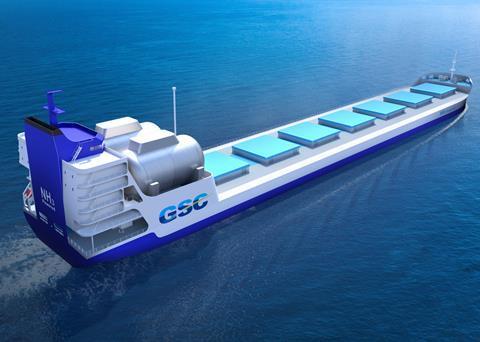ClassNK has released the latest ClassNK Technical Journal, which includes details of ammonia engine principles and safety considerations for the use of the fuel onboard.
Four safety levels have been defined: A where fuel is always present e.g. fuel tanks and piping; B where fuel is present when a leakage occurs; C where fuel is not present but the area must be separated by boundaries from A and B: and D where fuel should not be present e.g. accommodation spaces.
ClassNK included details of ammonia engine principles and safety considerations for the use of the fuel onboard in its latest ClassNK Technical Journal.
Safety measures are defined for these areas with special consideration given to the corrosiveness of ammonia in area A and its flammability and toxicity in area B. Areas A, B and C are to be separated by physical enclosures or by distance on open decks where physical enclosure is not possible. Leaks into area B should be detected immediately and the leak is to be shut off and the ammonia removed. If people are to enter area B in the event of an abnormality, it is to be confirmed that no ammonia is detectable.
The lower explosion limit of ammonia is about 15% which is higher than the limits of existing fuels, and its minimum ignition energy is 8mJ to 680mJ, which is higher than methane. However, ammonia could still create a potentially flammable environment in semi-enclosed or enclosed spaces, so ammonia fuel tanks must be protected from heat, and exposed parts on open decks are to be covered by a water spray system. Category A and spaces with a high risk of fire must be protected by A-60 class heat insulation and a 900mm cofferdam.
Emergency situations where the release of ammonia into the atmosphere or sea is allowed include when a fire occurs around an ammonia fuel tank and the pressure in the tank increases. The release of ammonia is not allowed during normal operations such as purging of bunkering lines or gas freeing of tanks and pipes during docking.
To guard against the toxicity of ammonia, ventilation inlets and outlets, openings of non-hazardous spaces, escape routes and lifeboats should all be separated by distances defined in ClassNK’s Guidelines for the Safety of Ships Using Ammonia as Fuel published in August 2021.
As well as ammonia, ClassNK’s Technical Journal No.5 2022 (I) focuses on zero-emission ships, including efforts of the planning and design of next-generation greener ships, development of onboard CO2 capture system, prospects for widespread adoption of next-generation standard EV vessel and efforts to reduce GHG emissions from ships.
In addition, the Technical Journal contains technical articles describing future fluidics analysis and an AI surrogate model for manufacturing, overview of changes and comprehensive revision of structural rules (Part C of the Rules for the Survey and Construction of Steel Ships), setting corrosion additions based on latest thickness measurement data, evaluation of the ship operational effect based on actually encountered sea states by ships, CBM life cycle maintenance, and recent topics at IMO.






